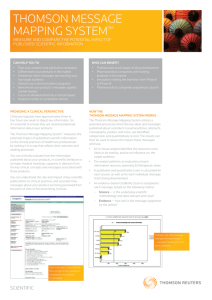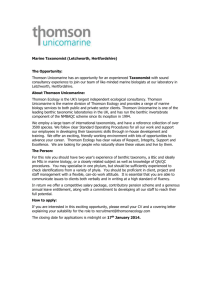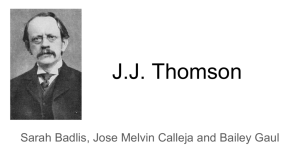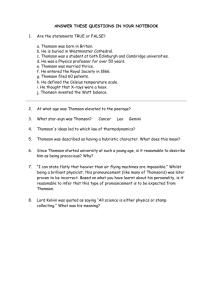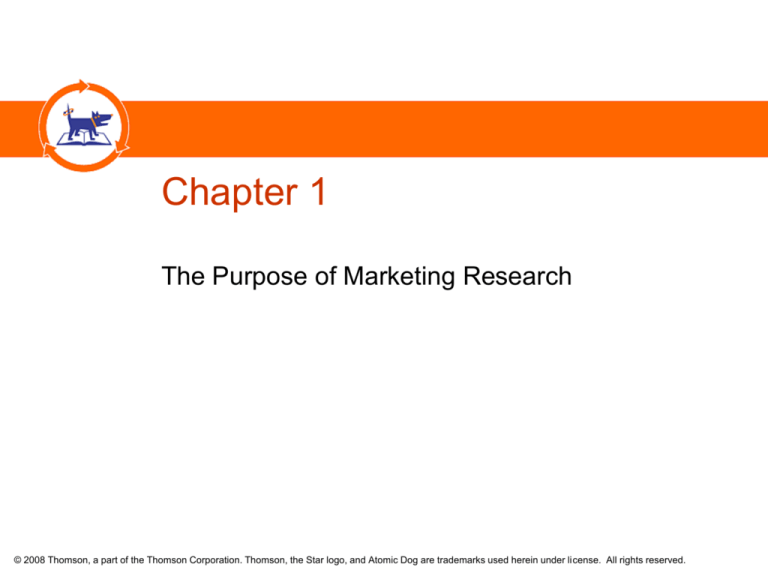
Chapter 1
The Purpose of Marketing Research
© 2008 Thomson, a part of the Thomson Corporation. Thomson, the Star logo, and Atomic Dog are trademarks used herein under license. All rights reserved.
What Is Marketing?
© 2008 Thomson, a part of the Thomson Corporation. Thomson, the Star logo, and Atomic Dog are trademarks used herein under license. All rights reserved.
1-2
What Is Marketing? (cont.)
• independent variables
inputs
includes:
- situational factors
- marketing courses of action to steer the market
• dependent variables
outputs, phenomena one seeks to explain
includes:
- behavioral responses of consumers to the independent
variables
- performance measures
• connecting variables
relationships between independent and dependent variables
discovered through marketing research
© 2008 Thomson, a part of the Thomson Corporation. Thomson, the Star logo, and Atomic Dog are trademarks used herein under license. All rights reserved.
Why should we do Marketing
Research?
• The individual (wo)man is an
insoluble puzzle, in the
aggregate (s)he becomes a
mathematical certainty.
© 2008 Thomson, a part of the Thomson Corporation. Thomson, the Star logo, and Atomic Dog are trademarks used herein under license. All rights reserved.
Why do we need Marketing
Research?
• Perception is Reality. Judgment-based vs. databased.
• Initial perceptions can lead to selective
interpretation. That may hurt your prospects.
• Environmental Changes.
• Proactive. Sustainable competitive advantage.
© 2008 Thomson, a part of the Thomson Corporation. Thomson, the Star logo, and Atomic Dog are trademarks used herein under license. All rights reserved.
-$4.000.000 in market research
-200.000 blind tests
-New coke outperformed old Coke
and Pepsi
-40.000 letters of complaint
-6000 calls a day
-In 87 days Coca Cola reintroduced
the Old Coke on the market
© 2008 Thomson, a part of the Thomson Corporation. Thomson, the Star logo, and Atomic Dog are trademarks used herein under license. All rights reserved.
How had the Coca-Cola management
got it so wrong?
• • They had focused on the product, not the brand.
• They had neglected the emotional value of 'Coke' to
the American public.
• They asked the wrong questions, so their research
provided irrelevant information.
• As one Coca-Cola official said at the time "We
betrayed a national trust". Why? Because they never
thought to ask American consumers how they would
feel about a change to Coke, whether or not they
would want a 'New Coke'.
© 2008 Thomson, a part of the Thomson Corporation. Thomson, the Star logo, and Atomic Dog are trademarks used herein under license. All rights reserved.
-Opened in New Orleans in 1995 as a temporary
casino
- Grossed less than half of $33 million it needed for
month in 9 weeks
-Losses in tens of millions
© 2008 Thomson, a part of the Thomson Corporation. Thomson, the Star logo, and Atomic Dog are trademarks used herein under license. All rights reserved.
How had the Harrah’s management
got it so wrong?
• auditorium's out-of-the-way location, next to a public
housing project
• ''People don't come here to gamble”
• Gambling analysts say the casino will have to make
about $260 million a year to pay its taxes and its
2,800 employees, which translates to 14,000 patrons
a day losing an average of $50 each.
• 14.000= New Orleans daily tourists population!
© 2008 Thomson, a part of the Thomson Corporation. Thomson, the Star logo, and Atomic Dog are trademarks used herein under license. All rights reserved.
• Sephora entered Japanese market in 1999 with plans
to launch 50 stores within the next two years.
• Built 7 stores in high-class locations
• In 2001 Sephora closed the doors to all of its 7 retail
locations and left the country.
• The failure in Japan is attributed to a lack of market
research and understanding local demands (for
example, making an accent on fragrances instead of
cosmetics and targeting older age groups).
© 2008 Thomson, a part of the Thomson Corporation. Thomson, the Star logo, and Atomic Dog are trademarks used herein under license. All rights reserved.
How had the Sephora’s management
got it so wrong?
• Upsetting the suppliers (products w/o the sales
support)
•
Confusing the consumer
Japanese are sensitive to the layout of the store: three floors,
perfumes in the first floor! (fragrance market in Japan=5%)
Self-service not so popular: Japanese ladies want to be
chatted to and pampered as a tradition before buying
Lack of Market Research!
© 2008 Thomson, a part of the Thomson Corporation. Thomson, the Star logo, and Atomic Dog are trademarks used herein under license. All rights reserved.
So, what then is Marketing
Research?
• Any decision that helps in making informed marketing
decisions.
Descriptive (gathering facts)
- What is the market share of our competitor?
Diagnostic (explaining data or actions)
- Will sales increase if wall color is changed?
Predictive
- Will this target market accept our product?
© 2008 Thomson, a part of the Thomson Corporation. Thomson, the Star logo, and Atomic Dog are trademarks used herein under license. All rights reserved.
Managerial Decision-Making
• Marketing research gathers information on consumer
needs to facilitate better production decisions.
Information gathering. Intelligence, if you want.
• Research methodology formalizes statistical
reasoning in the analysis and interpretation of data.
• Marketing vs. Market research
© 2008 Thomson, a part of the Thomson Corporation. Thomson, the Star logo, and Atomic Dog are trademarks used herein under license. All rights reserved.
Marketing Management Decisions
Formal decision-making process:
1. recognizing a problem or opportunity
2. clarifying the decision
3. identifying alternative courses of action
(i.e., combinations of marketing mix variables)
4. evaluating alternatives
5. selecting a course of action
6. implementing the selected course of action and
monitoring its effects
© 2008 Thomson, a part of the Thomson Corporation. Thomson, the Star logo, and Atomic Dog are trademarks used herein under license. All rights reserved.
1-1a
Research Methodologies for
Decision-Making
Steps of marketing research methodology:
1. Determine what information is needed
2. Design a method for collecting this information
3. Manage the data collection
4. Analyze and interpret the results
5. Communicate the findings in a way that clarifies
the implications for managerial decision making
© 2008 Thomson, a part of the Thomson Corporation. Thomson, the Star logo, and Atomic Dog are trademarks used herein under license. All rights reserved.
What Questions are Commonly
Addressed in MR?
5Cs
• Consumer: What needs do we seek to satisfy?
• Competition: Who competes with us?
• Company: What special competence do we
have?
• Collaboration: Who should we enlist to help us?
• Context: What external factors limit us?
© 2008 Thomson, a part of the Thomson Corporation. Thomson, the Star logo, and Atomic Dog are trademarks used herein under license. All rights reserved.
1-1c
Marketing Research Criteria
Criteria for marketing research:
• systematic: data gathering and analysis must be
designed and organized in advance
• objective: unbiased and impartial
• informational: collects data relevant to information
needs of decision-makers
• targeted for decision making: data gathered and
interpreted with the goal of reducing uncertainty
in a decision situation
© 2008 Thomson, a part of the Thomson Corporation. Thomson, the Star logo, and Atomic Dog are trademarks used herein under license. All rights reserved.
The “Three Questions” Rule
•
Before conducting any MR, ask yourself the
following three questions:
1.
2.
3.
•
What do I want to know?
Why do I need this information?
What decisions will I take once I've got
it?
Answering these three questions will lead to
ACTIONABLE RESEARCH.
© 2008 Thomson, a part of the Thomson Corporation. Thomson, the Star logo, and Atomic Dog are trademarks used herein under license. All rights reserved.
1-3b
The Marketing Management Process
Informational feedback between the marketing system
and decision making process
Figure 1-3
© 2008 Thomson, a part of the Thomson Corporation. Thomson, the Star logo, and Atomic Dog are trademarks used herein under license. All rights reserved.
1-3c
Information Needs
Information needs for improved decision-making include
information on:
•situational variables
economic climate, market trends, government regulation
•marketing mix variables
pricing, promotion, point-of-purchase displays, ad spending
•performance measures
monetary: sales, market share, profit, internal rate of return,
return on investment (ROI)
non-monetary: image, attitudes toward the organization,
consumer satisfaction, brand equity
© 2008 Thomson, a part of the Thomson Corporation. Thomson, the Star logo, and Atomic Dog are trademarks used herein under license. All rights reserved.
The Value of Marketing Research
• The value of any given research project depends on
the amount of money riding on related decisions.
IMPORTANCE.
• Decision rules:
If the decision already has been made,
and research will not affect it, then
research is not worthwhile.
If the decision has not been made, the
value of research depends on its ability to
provide clear direction. INFLUENCE.
© 2008 Thomson, a part of the Thomson Corporation. Thomson, the Star logo, and Atomic Dog are trademarks used herein under license. All rights reserved.
Illustrative Decision Model
0.6
Introduce
Success
$4 Mil
0.4 Failure
Case A
$1 Mil
$0
Do not introduce
How much will you willing to pay for perfect information
in this case?
© 2008 Thomson, a part of the Thomson Corporation. Thomson, the Star logo, and Atomic Dog are trademarks used herein under license. All rights reserved.
Illustrative Decision Model 2
0.6
Introduce
Success
$4 Mil
0.4 Failure
Case B
-$2.5 Mil
$0
Do not introduce
© 2008 Thomson, a part of the Thomson Corporation. Thomson, the Star logo, and Atomic Dog are trademarks used herein under license. All rights reserved.
Solution
• Expectation of the product’s eventual performance is
given by the expected value.
• EV = (PS * AmtS) + (PF * AmtF)
• EV = 0.6 * 4M + 0.4 (-2.5) = 1.4M.
• Introduce the product? YES.
• Would perfect information have value? YES.
• Value of Perfect Information = 0.4 * - 2.5M = -1M
© 2008 Thomson, a part of the Thomson Corporation. Thomson, the Star logo, and Atomic Dog are trademarks used herein under license. All rights reserved.
1-4
The Marketing Research Industry
• first research firm in 1911: The Business Bourse
• 1930s: modern probability sampling methodologies
• late 1930's and 1940's: shift to marketing concept,
first college courses and textbooks in MR
• MR institutions include organizations which use MR,
those which do MR for other organizations, and those
which do both
• main research types
consumer research: study of ordinary consumers
industrial research: study of industrial purchasers
(often not the actual consumers)
© 2008 Thomson, a part of the Thomson Corporation. Thomson, the Star logo, and Atomic Dog are trademarks used herein under license. All rights reserved.
1-4f
Organizational Structures
•centralized organizations
single corporate research department performs all research
better coordination and control of the research activity
more economical and flexible use of facilities and personnel
•decentralized organizations
company divisions have own research departments
more direct and specific interaction with area under study
more specialization to the division's needs and markets
better cooperation with divisional managers
Marketing research function is best placed near to where
marketing decisions are most often made.
© 2008 Thomson, a part of the Thomson Corporation. Thomson, the Star logo, and Atomic Dog are trademarks used herein under license. All rights reserved.
1-4h
Proposal Guidelines
Include, if available:
• definition of the problem
• decision objectives
• information needs
• alternative course of action
• personnel qualifications
• how the project will be evaluated
• project budget
• timetable
© 2008 Thomson, a part of the Thomson Corporation. Thomson, the Star logo, and Atomic Dog are trademarks used herein under license. All rights reserved.
Ethical Themes in Market Research
Ethical dimension not covered by MR methodology -must be constantly considered by decision-makers
Examples, performing research:
Examples, using research:
• integrity of the data
• deception of research suppliers
to take their proposed designs
• treatment of participants and
clients
• espionage
• bias
• subcontractors not held to
standards
• study design errors
• data not stored securely
• pressure on researchers to
favor personal viewpoint
• misuse of statistics
• details withheld to make a pet
project look better
• social context issues, such as
pollution, not covered by the
research
© 2008 Thomson, a part of the Thomson Corporation. Thomson, the Star logo, and Atomic Dog are trademarks used herein under license. All rights reserved.


